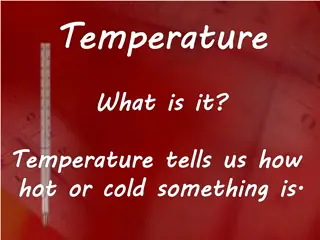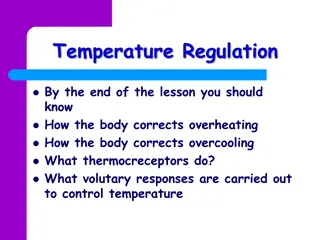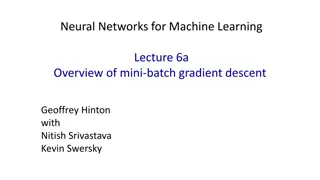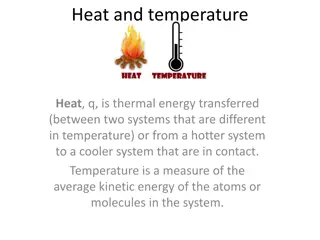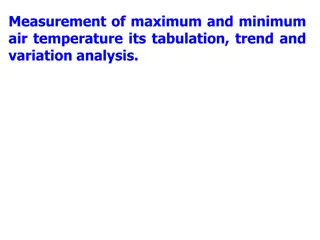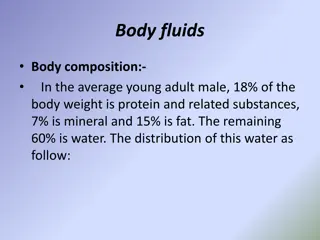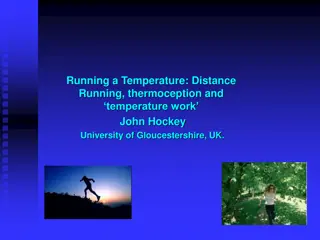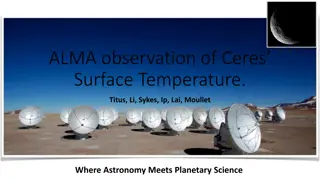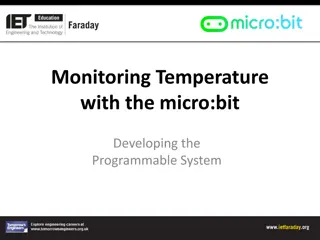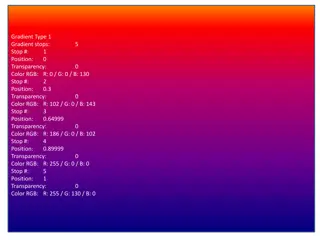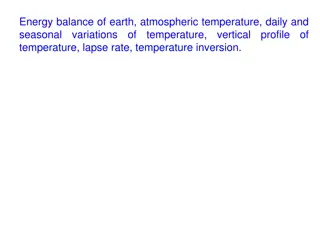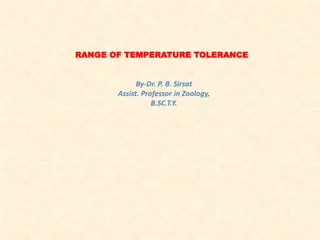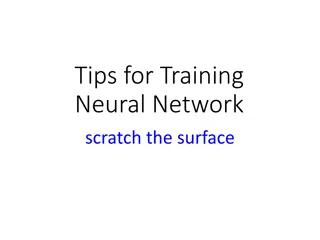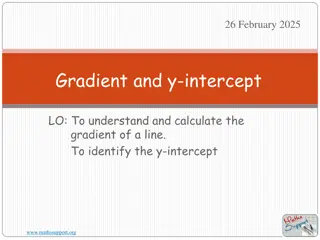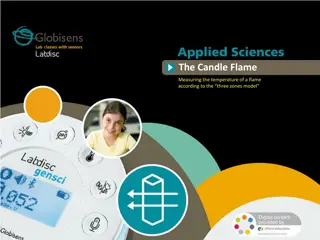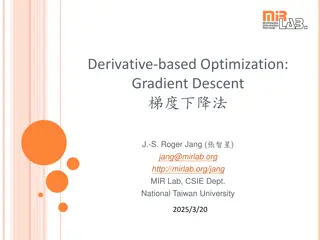Basic Principles of MRI Imaging
MRI, or Magnetic Resonance Imaging, is a high-tech diagnostic imaging tool that uses magnetic fields, specific radio frequencies, and computer systems to produce cross-sectional images of the body. The components of an MRI system include the main magnet, gradient coils, radiofrequency coils, and the
6 views • 49 slides
Temperature and Color Relationship in Candle Flames
Explore the relationship between temperature and color in candle flames through the three zones model. By conducting experiments using a thermocouple sensor, investigate how the color gradient in a flame correlates with its temperature variations. Learn about the structure of a candle flame, the inf
5 views • 21 slides
Slope, Gradient, and Intervisibility in Geography
Explore the concepts of slope, gradient, and intervisibility in geography through detailed descriptions and visual representations. Learn about positive, negative, zero, and undefined slopes, the calculation of gradient, and the significance of understanding these aspects in various engineering and
2 views • 12 slides
A Comprehensive Guide to Gradients
Gradients are versatile tools in design, allowing shapes to transition smoothly between colors. Learn about gradient types, preset options, creating your own metallic gradients, and applying gradients effectively in this detailed guide. Explore linear and radial gradient directions, understand gradi
3 views • 7 slides
Temperature: Facts, Measurement, and Scales
Understanding temperature is crucial in daily life. This content delves into the definition, measurement, and scales of temperature, highlighting key facts such as body temperature, freezing and boiling points of water, and extreme temperatures like those found in lightning and the sun. Discover how
5 views • 9 slides
Temperature Effects on Donor and Acceptor Ionization in Semiconductors
Temperature plays a crucial role in the ionization of donor and acceptor atoms in semiconductors. In N-type semiconductors, the Fermi level lies below the conduction band, while in P-type semiconductors it lies above the valence band, with the position depending on temperature and impurity atoms. Do
4 views • 13 slides
Body Temperature Regulation
Explore how the body maintains its internal temperature through mechanisms such as correcting overheating and overcooling, the role of thermoreceptors, and voluntary responses that help control temperature. Discover the importance of regulating internal body temperature for optimal enzyme-catalyzed
3 views • 18 slides
Mini-Batch Gradient Descent in Neural Networks
In this lecture by Geoffrey Hinton, Nitish Srivastava, and Kevin Swersky, an overview of mini-batch gradient descent is provided. The discussion includes the error surfaces for linear neurons, convergence speed in quadratic bowls, challenges with learning rates, comparison with stochastic gradient d
3 views • 31 slides
Efficient Gradient Boosting with LightGBM
Gradient Boosting Decision Tree (GBDT) is a powerful machine learning algorithm known for its efficiency and accuracy. However, handling big data poses challenges due to time-consuming computations. LightGBM introduces optimizations like Gradient-based One-Side Sampling (GOSS) and Exclusive Feature
2 views • 13 slides
Heat and Temperature in Thermodynamics
Thermal energy transfer, heat, and temperature play crucial roles in determining the behavior of systems in terms of kinetic energy and molecular motion. The zeroth law of thermodynamics establishes the relationship between heat and temperature. Heat transfer leads to changes in the average kinetic
8 views • 8 slides
Temperature Measurement in Plant Growth
Exploring the measurement of maximum and minimum air temperature, its significance in analyzing trends and variations, and how temperature impacts plant growth stages. The optimal temperature ranges for different plant species and the importance of maximum and minimum temperature recordings using sp
4 views • 20 slides
Optimization Methods: Understanding Gradient Descent and Second Order Techniques
This content delves into the concepts of gradient descent and second-order methods in optimization. Gradient descent is a first-order method utilizing the first-order Taylor expansion, while second-order methods consider the first three terms of the multivariate Taylor series. Second-order methods l
2 views • 44 slides
Body Fluids and Composition in the Human Body
The body composition of an average young adult male includes protein, mineral, fat, and water in varying proportions. Water is the major component, with intracellular and extracellular distribution. Movement of substances between compartments occurs through processes like simple diffusion and solven
0 views • 37 slides
Hessian-Free Optimization in Neural Networks
A detailed exploration of Hessian-Free (HF) optimization method in neural networks, delving into concepts such as error reduction, gradient-to-curvature ratio, Newton's method, curvature matrices, and strategies for avoiding inverting large matrices. The content emphasizes the importance of directio
3 views • 31 slides
The Phenomenology of Temperature Awareness in Distance Running
Researchers at the University of Gloucestershire explore the embodied consciousness of distance runners, focusing on thermoception and temperature regulation. Utilizing sociological phenomenology and phenomenological ethnography, the study delves into the sensory experiences of runners, emphasizing
1 views • 29 slides
Temperature: From Touch to Thermometer
Explore the concept of temperature in Year 4 lesson 1, understanding that touch is not always accurate in judging temperature. Engage in activities to test different temperatures and discover the limitations of using the sense of touch. Lesson 2 introduces using a thermometer to measure temperature
3 views • 43 slides
Comprehensive Solution for EU Digital COVID Certificate Verification
This solution offers face recognition, temperature monitoring, and verification of EU Digital COVID Certificates for personnel. It includes products like DHI-ASI7213X-V1-T1 and ASF172X-T1, with various unlocking modes and support for certificate verification. The system allows for accurate and fast
1 views • 7 slides
ALMA Observation of Ceres Surface Temperature
ALMA conducted ground-based observations of Ceres' surface temperature providing valuable insights for planetary science. The data processing steps involved models interpolation, radio calibration, and thermal gradient correction to produce thermal flux maps. Key objectives included detecting the ed
5 views • 9 slides
Low Temperature Thermometry Overview
Temperature measurement, known as thermometry, involves assessing local temperature levels for various applications. A good low-temperature thermometer should offer reproducibility, high sensitivity, and a wide operating range. Primary thermometers directly measure properties of matter, while second
6 views • 25 slides
Developing a Food Temperature Probe with BBC micro:bit
Design and develop a programmable system using the BBC micro:bit to create a prototype food temperature probe. The system should include a temperature sensor to detect food temperature, a buzzer to sound a warning if the food is too cold, and an LED screen to display the food temperature. Follow the
6 views • 9 slides
Gradient Types and Color Patterns
The content describes various gradient types and color patterns using RGB values and positioning to create visually appealing transitions. Each gradient type showcases a unique set of color stops and positions. The provided information includes detailed descriptions and links to visual representatio
5 views • 24 slides
Earth's Energy Balance and Temperature Variations
Earth's energy balance is crucial for maintaining atmospheric temperature and regulating daily and seasonal temperature changes. The net radiation, consisting of incoming shortwave and outgoing longwave radiation, plays a key role in this balance. Components such as sensible heat flux, latent heat o
2 views • 18 slides
Unsteady Hydromagnetic Couette Flow with Oscillating Pressure Gradient
The study investigates unsteady Couette flow under an oscillating pressure gradient and uniform suction and injection, utilizing the Galerkin finite element method. The research focuses on the effect of suction, Hartmann number, Reynolds number, amplitude of pressure gradient, and frequency of oscil
1 views • 17 slides
Body Temperature Regulation and Factors Affecting It
Body temperature regulation is a complex process involving the balance of heat production and loss. Factors like age, hormones, stress, and environmental changes can influence body temperature. Heat production is affected by factors such as basal metabolic rate, muscle activity, fever, and sympathet
4 views • 24 slides
Temperature Tolerance of Organisms in the Universe
Life on Earth exists within a range of temperatures, with organisms displaying varied temperature tolerance. Eurythermal organisms can withstand large temperature fluctuations, while stenothermal organisms tolerate only small variations. The temperature range for each species is crucial for their ph
2 views • 8 slides
Essential Tips for Training Neural Networks from Scratch
Neural network training involves key considerations like optimization for finding optimal parameters and generalization for testing data. Initialization, learning rate selection, and gradient descent techniques play crucial roles in achieving efficient training. Understanding the nuances of stochast
3 views • 23 slides
Gradient and y-intercept
Learn how to calculate the gradient of a line and identify the y-intercept in mathematics. Understand the concept of gradient as a measure of slope and explore the relationship between vertical and horizontal movements. Find out how to apply the gradient formula using two points on a line.
1 views • 13 slides
ILC Gradient R&D Progress and Challenges in Accelerator Technology
Explore the latest advancements and hurdles in the ILC Gradient R&D, including the successful accomplishment of goals, reduction of gradient scatter, and plans for future developments. Discover the ongoing efforts to push the gradient envelope, improve fabrication processes, qualify new vendors, and
0 views • 4 slides
Candle Flame Temperature Study: Color and Heat Relationship
Explore the relationship between temperature and color in a candle flame using the three zones model. Learn how the flame structure, color gradient, and temperature distribution reveal fascinating insights. Conduct experiments to test hypotheses and understand the scientific complexities behind the
1 views • 21 slides
Optimize Derivative-Based Functions Using Gradient Descent
Explore the concept of derivative-based optimization through Gradient Descent, a technique to minimize functions based on gradients. Learn about directional derivatives, computing gradients, and the formula for Gradient Descent with examples and animations.
3 views • 18 slides
Cavity Gradient Degradation in XFEL Cryomodule Tests
Explore the details of cavity gradient degradation in XFEL cryomodule tests presented by Denis Kostin at the DESY TTC Topical Meeting. The content covers cavity operating gradient, XFEL module AMTF test data, statistics on degraded cavities, and critical gradient degradation criteria. Gain insights
1 views • 10 slides
RNNs, LSTMs, and Gradient Issues in Deep Learning
Dive into the world of Recurrent Neural Networks (RNNs) and Long Short-Term Memory (LSTM) networks, exploring concepts such as exploding and vanishing gradients. Discover how LSTM solves the vanishing gradient problem and learn about gradient clipping. Explore various implementations and references
4 views • 13 slides
Simple Gradient Information Extraction for Diffusion Gradients
Extract gradient information easily with a Python script for multi-shell diffusion gradients. View, analyze, and process gradient vectors in NIfTI file format with commands like info, symmetry, print, and show.
2 views • 8 slides
Straight Line Graphs: Understanding Gradient Calculation
Practice finding the gradient between two points on straight line graphs in this interactive learning session. Work through examples and test your knowledge by determining the gradient for various points. Improve your understanding of how to calculate gradients efficiently.
0 views • 4 slides
Gradient Functions in Calculus
Explore the concept of gradient functions in calculus, including differentiation, finding gradients of curves, and understanding how gradients change. Learn about the gradient functions of y = x^2 and y = x^3 and how to calculate gradients at specific points. Discover the significance of positive gr
4 views • 16 slides
Create Android Gradient Shapes Easily with XML
Learn how to create gradient shapes in Android using XML by following simple steps such as creating a new XML file, defining gradient elements, and adding them to your layout for a visually appealing design.
1 views • 6 slides
Understanding Gradient Checks for Artificial Neural Networks
Learn about gradient checks in artificial neural networks, including finite differences, comparing numerical and analytic gradients, handling relative errors, and debugging procedures to ensure correct gradient computations.
0 views • 8 slides
Fine-Tuning Gradient Dynamics
Explore the dynamics of low-rank fine-tuning beyond kernels in the context of gradient dynamics. Key bottleneck: Spurious Paulis and anticoncentration lemma explained. Form of the gradient and more insights revealed.
0 views • 4 slides
Gradient Features for Text Image Classification
Explore how Local Gradient Difference features are used for the classification of 2D and 3D natural scene text images. This paper discusses text detection performance before and after classification, showcasing the effectiveness of the proposed method. Various techniques such as Candidate Pixel Dete
0 views • 13 slides
Atmospheric Motion Dynamics Overview
Explore the concept of pressure gradient force, scales of atmospheric motion, the second law of Newton, and the direction of pressure gradient force in meteorology. Learn about calculating pressure gradient force, mass of differential volume elements, and acceleration estimation in atmospheric dynam
0 views • 9 slides




